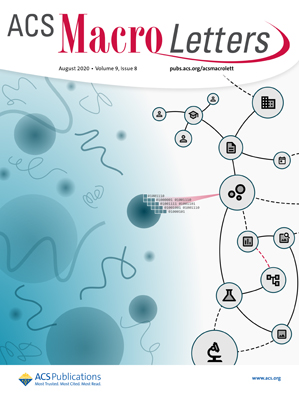揭示多机械基团嵌段共聚物的机械化学力分布
IF 5.2
Q1 POLYMER SCIENCE
引用次数: 0
摘要
聚合物力学化学是在超声条件下研究最多的,其中沿着聚合物链的力分布通常被建模为以链中点为中心的抛物线。机械激活所需的力向链端延伸多远仍然是一个感兴趣的问题。研究机械团在远离链中心和末端的特定位置的机械化学反应性将提供有价值的信息,但是制备这样的聚合物来研究机械团的位置和链长对机械活化的影响一直是合成上的麻烦。采用简单的操作程序,我们通过梯子烯型机械基团和降冰片烯的活环开环复分解聚合合成了一系列含有机械基团的嵌段共聚物,并对嵌段位置和长度进行了很好的控制。我们发现,对于初始聚合度(DP)≈1000的聚合物,末端机械团块的活化程度低于位于中心位置的聚合物。然而,仅仅通过延长机械化学惰性基团的长度,DP≈200的末端机械团块在诱导期后获得了惊人的高机械活化程度,与那些位于中心的机械团或机械团均聚物相当。这些发现表明,在超声条件下,聚合物链上的高力覆盖范围很广,并且在远离链中心的地方仍然有可能实现高度的生产机械化学。本文章由计算机程序翻译,如有差异,请以英文原文为准。

Revealing Mechanochemical Force Distributions with Polymechanophore Block Copolymers
Polymer mechanochemistry is most studied under ultrasonication conditions, where the force distribution along a polymer chain is typically modeled as a parabola centered at the chain midpoint. How far the forces required for mechanoactivation extend toward the chain ends remains a question of interest. Investigating the mechanochemical reactivity of mechanophores at defined locations off chain center and toward termini would provide valuable information regarding this, but preparing such polymers to study the effects of mechanophore location and chain length on mechanoactivation has been synthetically cumbersome. Using an operationally simple procedure, we synthesized a series of block copolymers containing a block of mechanophores by living ring opening metathesis polymerization of a ladderene-type mechanophore and a norbornene, with good control over block positions and lengths. We found that for polymers of initial degrees of polymerization (DP) ≈ 1000, terminal mechanophore blocks activated less than more centrally located ones. However, simply by extending the length of the mechanochemically inert block, terminal mechanophore blocks of DP ≈ 200 achieved surprisingly high degrees of mechanoactivation comparable to those of centrally located ones or mechanophore homopolymers, after an induction period. These findings revealed the broad range of high force coverage along a polymer chain under sonication conditions and the possibility to still achieve high degrees of productive mechanochemistry far away from chain centers.
求助全文
通过发布文献求助,成功后即可免费获取论文全文。
去求助
来源期刊
CiteScore
10.40
自引率
3.40%
发文量
209
审稿时长
1 months
期刊介绍:
ACS Macro Letters publishes research in all areas of contemporary soft matter science in which macromolecules play a key role, including nanotechnology, self-assembly, supramolecular chemistry, biomaterials, energy generation and storage, and renewable/sustainable materials. Submissions to ACS Macro Letters should justify clearly the rapid disclosure of the key elements of the study. The scope of the journal includes high-impact research of broad interest in all areas of polymer science and engineering, including cross-disciplinary research that interfaces with polymer science.
With the launch of ACS Macro Letters, all Communications that were formerly published in Macromolecules and Biomacromolecules will be published as Letters in ACS Macro Letters.

 求助内容:
求助内容: 应助结果提醒方式:
应助结果提醒方式:


